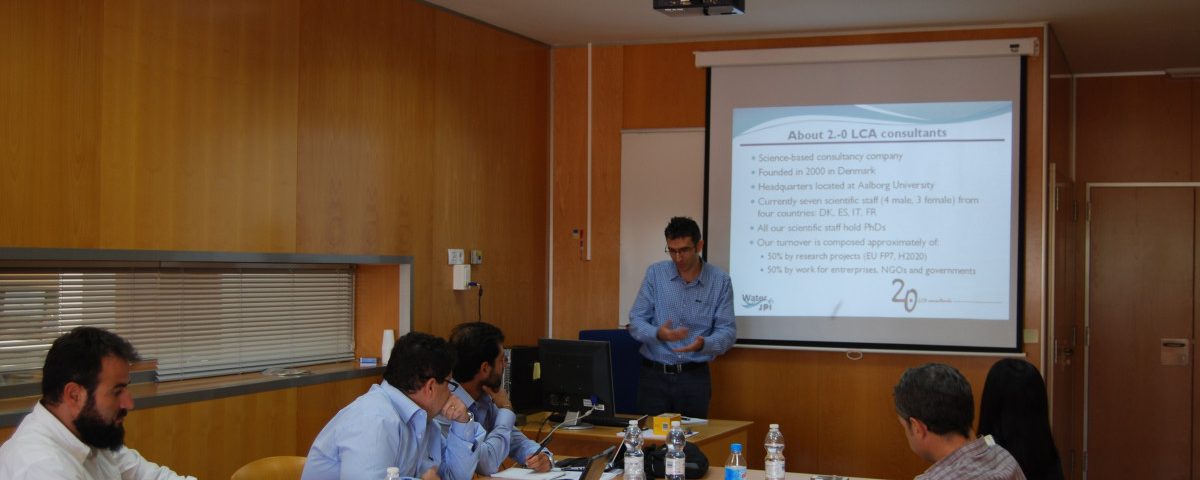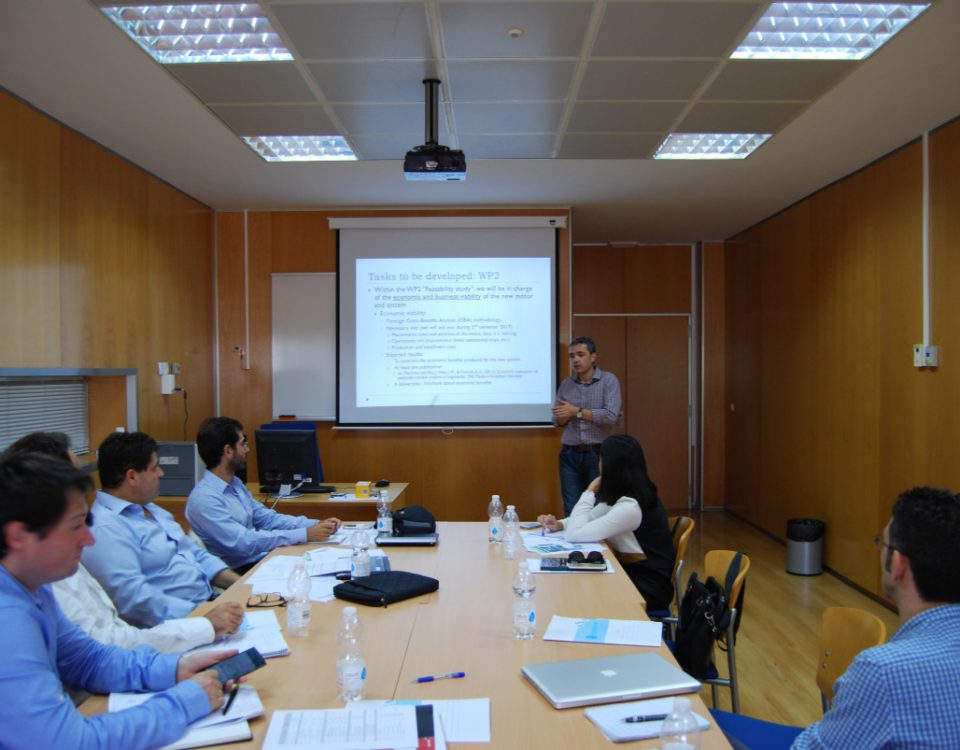Therbior celebrates its third meeting in Barcelona
25 abril, 2017
Therbior celebrates its third meeting in Barcelona
28 abril, 20171.Welcome‐ introduction of participants
Mr Francisco Javier Batlles Garrido welcomed participants and opened the meeting. Mrs Sabina Rosiek (nominated by the Francisco Javier Batlles Garrido for this task) emphasized that, decisions concerning the management and activities of the project should be agreed on during the meeting.
2. Review of Key Project Aims and Objectives
Mrs Rosiek provided an overview of the aims, objectives and development of the THERBIOR project. She also present and explained the list of deliverables and milestones.
3. WP1 ‐ General Overview
Claudio Di Iaconi presented an overview of the CNR‐IRSA role in the project. Marco De Sanctis provided a presentation on the SBBGR plant with a special focus on its main characteristics. MDS presented a resume of key issues associated with particular SBBGR design, highlighting its operation modes and requirements for optimal operation. CDI explained the temperature range of the SBBGR. He stated that the SBBGR’s optimal set point is from 15°C to 22°C for annual operation and not 20°C to 27°C (as he mentioned during the project kick‐off meeting). MDS presented all details of the upgraded during September, already existing (located next to the SBBGR at CNR‐IRSA site) workshop with the main goal to enable it as the experimental test laboratory (ETL). The aforementioned workshop was divided in two separate spaces and updated as a machinery room and ETL (as a test stand for cooling, heating and domestic hot water purposes) respectively 4. WP2‐ General Overview
Iñaki Acasuso Pérez (IAP) and Francisco Portillo (FP) from Hedera Helix Ingenieria y Biotecnologia S.L project partner provided the detailed information of all already installed (at CNR‐IRSA site) sensors required for suitable SBBGR and process monitoring. FP resumed also a supervisory control and data acquisition system (SCADA) that was installed for the SBBGR. During the 1st semester meeting, Hedera Helix project partner provided conceptual input for the development SCHW system prototype (WP2). After discussion, it was agreed that within few weeks Hedera Helix will provide the general lay‐out of the SCHW prototype with measurement sensors that will install within WP2. All project’s partners will be responsible for verify all design parameters and once everyone has agreed will approve (sign) the SCHW final design. Further progress will be reported by the next meeting.
5. WP3‐ General Overview
SR presented a review of the planned activities within WP3. The feasibility study of THERBIOR prototype will be assessed in terms of its energy savings, initial costs, operating costs, payback period and environmental performance. To fulfill THERBIOR goals, SR highlighted that UAL will need, SCHW system developed and running at CNR‐IRSA site, SBBGR reactor’s monitoring data developed, optimal SCHW system’s operation mode selected and at least half a year of gathered good quality data.
6. WP4‐ General Overview
Ivan Muñoz (IM) from 2.0‐LCA Consultants presented an overview of the 2.0‐LCA Consultants role in the project. IM provided a presentation on the activities planned within WP4 and comprehensive description on the methodology of the planned studies. After long discussion on the proper selection of reference cases for both studied countries, namely Italy and Spain, it was agreed that THERBIOR will assessed: a scenario where the thermal recovery system is installed in a municipal wastewater treatment plant in Italy, and a scenario where the system is installed in decentralized wastewater treatment plant in an hotel facility in Spain. Moreover, 2.0. ‐ LCA Consultants will provide a template (questionnaire) with guidelines in order to make clear the information that CNR‐IRSA and Hedera Helix should provide about SCHW specifications necessary to carry out the LCA and LCC of the proposed system.
7. WP5‐ General Overview
Javier Martínez del Río (JMR) from International Managment School (UAL) presented an overview of the role of its research team in the THERBIOR project as well project work plan: degree of achievement; review of tasks to be done within the first year and first term second year (until October 2017); dependencies between activities; things to be done: deadlines for WP3 and WP5; risks and mitigating actions. Furthermore, it was agreed that International Management School will provide a detailed list of information required to analyse THERBIOR innovative application’s viability for incorporation into Almeria’s (Spain) and Bari’s (Italy) tourist facility network.
8. Action Required: Deadline for this first part of the WP2.
15.11.2016
2.0‐LCA Consultants will send to CNR‐IRSA and Hedera Helix a questionnaire related to the proposed THERBIOR system with the main goal to start collect data required for LCA and LCC analysis.
16.12.2016
Hedera Helix will send to all partners (for their approval) the detailed scheme of the proposed SCHW system with all its specification.
22.12.2016
All project partners will respond to Hedera Helix about verification of the SCHW final design parameters.
30.12.2016
CNR‐IRSA and Hedera Helix partners will respond to 2.0‐LCA Consultants about first data required for LCA and LCC analysis.
9. Reporting and Evaluation Procedures
Sabina Rosiek stated that every partner will be required to accomplish the project goals in the given timeframe. A number of deliverables was specified in the research proposal. A key deliverable will be a set of reports. All documents generated will be made available to the THERBIOR consortium through the project’s web‐site that is already running (http://www2.ual.es/therbior/). It was agreed that a constant stream of publications should originate from the project. All partners are encouraged to publish about the project (e.g. articles, website posts etc.). Communication and dissemination materials (websites, posters, presentations, papers, etc.) should clearly mention and acknowledge the source of funding, including the Water JPI, the WaterWorks2014 project, the European Commission, and the respective FPOs, as bellow:
“The authors would like to thank the EU and (enter National funder name) for funding, in the frame of the collaborative international consortium (THERBIOR) financed under the ERA‐NET Cofund WaterWorks2014 Call. This ERA‐NET is an integral part of the 2015 Joint Activities developed by the Water Challenges for a Changing World Joint Programme Initiative (Water JPI).”
All Reports for the Water JPI and presentations at Water JPI events should use the electronic templates, provided via the Water JPI website. The project website, posters, presentations, videos and other visual media, must additionally include the logo of the Water JPI [Project Management Guidelines. Water JPI].
10. Project Timeline
The proposed project schedule was distributed during the meeting. After discussion and due to specific SBBGR operation mode, it was agreed to slightly amend the proposed schedule for the D1.1 (Report on daily and seasonal temperature trends and SBBGR reactor efficiency) and D1.2 (Report on energy balance and a thermal energy recovery rate evaluation) until M18. It was agreed that from 15.10.2016 CNR‐IRSA and Hedera will be monitoring the SBBGR performance with the aim to use this information as for further analysis.
– See more at: http://www2.ual.es/therbior/2017/04/25/almeria-meeting/#sthash.8yNLjk8l.dpuf


